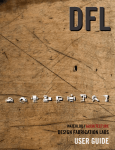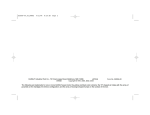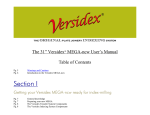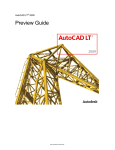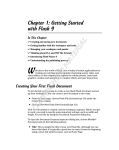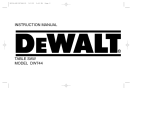Download Black & Decker PLATE JOINER 3382 Instruction manual
Transcript
DEWALT Industrial Tool Company, 626 Hanover Pike, P.O. Box 158, Hampstead, MD 21074 Printed in U.S.A. (SEP95-CD-1) Form No. 154527 For information call toll free between 8:00 a.m. and 8:00 p.m. ET, seven days a week. 1-800-4-DEWALT (1-800-433-9258). DW682 Copyright 1995 INSTRUCTION MANUAL MANUAL DE INSTRUÇÕES MANUAL DE INSTRUCCIONES DW682 Plate Joiner Fresadora DW 682 IF YOU HAVE ANY QUESTIONS OR COMMENTS ABOUT THIS OR ANY DEWALT TOOL, CALL US TOLL FREE AT 1-800-4-DEWALT (1-800-433-9258). Serial Number from Nameplate Date of Purchase AUXILIARY HANDLE SPINDLE LOCK PIN LOCK ON BUTTON DANG _B E R: Save this information for future reference ADJUSTABLE FENCE R 0 15 30 45 60 75 90 NCE INDUSTR GH PER HI DEWALT…BUILT JOBSITE TOUGH D E WALT high performance industrial tools are made for America’s toughest industrial and construction applications. The design of every tool in the line—from drills to sanders to grinders—is the result of rigorous use on jobsites and throughout industry. Each tool is produced with painstaking precision using advanced manufacturing systems and intense quality control. Every tool is checked before it leaves the factory to make sure that it meets your standards for durability, reliability and power. DEWALT Built Jobsite Tough…WE GUARANTEE IT. FIXED SHOE IA OOLS MA LT RMA FO D E IN T H E U . S . A TRIGGER SWITCH . PLUNGE DEPTH ADJUSTMENT KNOB Important Safety Instructions WARNING: When using Electric Tools, basic safety precautions should always be followed to reduce risk of fire, electric shock, and personal injury, including the following • Read all Instructions • • KEEP WORK AREA CLEAN. Cluttered areas and benches invite injuries CONSIDER WORK AREA ENVIRONMENT. Don’t expose power tools to rain. Don’t use power tools in damp or wet locations. Keep work area well lit. GUARD AGAINST ELECTRIC SHOCK. Prevent body contact with grounded surfaces. For example: pipes, radiators, ranges, refrigerator enclosures. KEEP CHILDREN AWAY. All visitors should be kept away from work area. Do not let visitors contact tool or extension cord. STORE IDLE TOOLS. When not in use, tools should be stored in dry, and high or locked-up place - out of reach of children. DON’T FORCE TOOL. It will do the job better and safer at the rate for which it was intended. USE RIGHT TOOL. Don’t force small tool or attachment to do the job of a heavy-duty tool. Don’t use tool for purpose not intended, for example, don’t use circular saw for cutting tree limbs or logs. DRESS PROPERLY. Do not wear loose clothing or jewelry. They can be caught in moving parts. Rubber gloves and non-skid footwear are recommended when working outdoors. Wear protective hair covering to contain long hair. USE SAFETY GLASSES. Also use face or dustmask if cutting operation is dusty. DON’T ABUSE CORD. Never carry tool by cord or yank it to disconnect from receptacle. Keep cord from heat, oil, and sharp edges. SECURE WORK. Use clamps or a vise to hold work. It’s safer than using your hand and it frees both hands to operate tool. DON’T OVERREACH. Keep proper footing and balance at all times. MAINTAIN TOOLS WITH CARE. Keep tools sharp and clean for better and safe performance. Follow instructions for lubricating and changing • • • • • • • • • • • • • • • • • • accessories. Inspect tool cords periodically and if damaged have repaired by authorized service facility. Inspect extension cords periodically and replace if damaged. Keep handles dry, clean, and free from oil and grease. DISCONNECT TOOLS. When not in use, before servicing, and when changing accessories, such as blades, bits, cutters. REMOVE ADJUSTING KEYS AND WRENCHES. Form habit of checking to see that keys and adjusting wrenches are removed from tool before turning it on. AVOID UNINTENTIONAL STARTING. Don’t carry plugged-in tool with finger on switch. Be sure switch is off when plugging in. OUTDOOR USE EXTENSION CORDS. When tool is used outdoors, use only extension cords intended for use outdoors and so marked. STAY ALERT. Watch what you are doing. Use common sense. Do not operate tool when you are tired. CHECK DAMAGED PARTS. Before further use of the tool, a guard or other part that is damaged should be carefully checked to determine that it will operate properly and perform its intended function. Check for alignment of moving parts, binding of moving parts, breakage of parts, mounting, and any other conditions that may affect its operation. A guard or other part that is defective should be properly repaired or replaced by an authorized service center unless otherwise indicated elsewhere in this instruction manual. Have defective switches replaced by authorized service center. Do not use tool if switch does not turn it on and off. DO NOT OPERATE portable electric tools near flammable liquids or in gaseous or explosive atmospheres. Motors in these tools normally spark, and the sparks might ignite fumes. SAVE THESE INSTRUCTIONS FOR FUTURE USE 1 Introduction Examine Figure 1 and your plate joiner for a few minutes to become familiar with the various features and the names used to describe them. The following sections will discuss the various controls and you will need to know where they are. FIG 1 AUXILIARY HANDLE LOCK KNOB LOCK ON BUTTON HEIGHT ADJUSTMENT KNOB R Overview DUST EXHAUST PORT You have purchased a precision woodworking tool. The function of the plate joiner is to enable you to make extremely strong and accurate joints in wood and wood byproducts. The tool works by a plunging action to precisely cut crescent shaped slots for the placement of flat wooden dowels or “biscuits” like those shown in Figure 2. The various adjustments on the patented base/fence assembly will enable you to make virtually any biscuit joint imaginable. The tool may be further enhanced by some simple jigs and fixtures that can be easily made. Some of the more common biscuit joinery applications are shown in Figure 3 and are discussed in detail in the applications section of this manual. TRIGGER SWITCH R ADJUSTABLE FENCE PLUNGE DEPTH ADJUSTMENT KNOB ANTI-SLIPPAGE PIN LOCK KNOB FIG 2 1/2" (12.7 mm) Switch Your plate joiner has a trigger switch located on the underside, as shown in Figure 1. To turn the tool on, depress the trigger. To turn the tool off, release the trigger. To lock the tool on for continuous operation, there is a lock on button located at the rear of the tool just above the cord. When cutting always hold the tool with one hand on the switch handle and one hand on the auxiliary handle. To lock the tool on, depress and hold the trigger as you depress the lock button. Hold the lock button in as you gently release the trigger. The tool will continue to run. To turn the tool off from a locked on condition, depress and release the trigger once. 2 3/8" (60 mm) (flat biscuits) 2 3/8" (9.5 mm) 2 3/16" (56 mm) #20 5/16" (8 mm) 1 13/16" (46mm) #10 #0 Blade Replacement FIG 3 EDGE TO EDGE JOINT In time your saw blade will wear out and need replacement. To remove the blade, follow the steps below. 1. Turn off and unplug the plate joiner. 2. Remove the 4 torx head screws from the bottom of the shoe, using the T20 torx screwdriver provided. 3. Rotate the shoe out of the way. 4. Use the spanner wrench provided to loosen (counterclockwise) the blade nut. Depress the spindle lock pin on the top of the gear case to hold the spindle while you unscrew the nut. 5. Remove the blade and have it sharpened or replace it with a new one. 6. Reinstall the blade by reversing the steps above. Be sure blade teeth point counterclockwise as shown in Figure 4. 7. IMPORTANT: Always check the fine depth adjustment when sharpening or replacing the blade. Adjust if necessary. (See “Controls” section). EDGE MITRE JOINT "T" JOINT CORNER JOINT 45° FRAME JOINT OFFSET OFFSET JOINT The Controls The heart of your plate joiner is the base/fence assembly. All of the controls that let you make a variety of precision cuts are located on this assembly. Take a few minutes to become familiar with the various controls. ALWAYS TURN OFF AND UNPLUG PLATE JOINER BEFORE MAKING ANY ADJUSTMENTS. R 1. ADJUSTABLE FENCE The adjustable fence provides a sturdy, precise reference surface to determine the point at which the slots for the biscuits will be cut. Its adjustable height feature allows you to position biscuit slots as close as 3/16" (4.76mm) and as distant as 1-3/8" (35mm) FIG 4 3 measured from the workpiece surface to the centerline of the blade (see Figure 6). The adjustable angle feature allows a full range of settings from 0° to 90 as well as a reverse 45° bevel which allows outside registration on miter joints. (See Applications section under Miter Joints, Figure 27.) The height adjustment is accomplished by first loosening the lock knob on the right side of the fence and then rotating the knurled adjustment knob until the desired height is reached (see Figure 5). Tightening the lock knob will then automatically align the fence parallel to the blade and lock it in position. The vertical scale and pointer located directly under the lock knob can be used to assist in setting this height. The scale readings indicate distance from the blade centerline to the fence surface when the fence is set at 90° (see Figure 6). If the depth scale ever needs to be adjusted, loosen the two screws that secure the scale and move the scale until the pointer is indicating the proper reading (see Figure 6). FIG 5 ADJUSTMENT KNOB LOCK KNOB FIG 6 2. PLUNGE DEPTH ADJUSTMENT The depth of cut can be set to match the dimensions of the particular size biscuit you will be using. The numbers on the depth adjustment knob (0,10,20,M) coincide with the three sizes of biscuits shown in Figure 2. The letter M stands for the maximum depth capacity of the tool which is 20mm (25/32"). This depth is obtainable only with a new blade and by backing out the fine adjustment screw (see next section). NOTE: The M setting has been provided for future use and will not be necessary for most biscuiting operations. To select a depth, align the appropriate number with the red mark scribed in the tool’s housing, as shown in Figure 7. Rotate the depth adjustment knob to the desired position and it will “click” into place. POINTER POINTS TO 1/2" MARK 1/2" CENTERLINE OF BLADE R 20 M 0 10 RED MARK FIG 7 4 FIG 8 3. FINE DEPTH ADJUSTMENT You may encounter situations where you want to leave a little looseness in your joint so that you can move it slightly before the glue sets up. For these instances a fine depth adjustment has been provided. To adjust, you must first raise the adjustable fence to its uppermost position. Then insert the T20 torx screwdriver provided into the opening as shown in Figure 8. Turn the depth adjustment screw clockwise for less depth and counterclockwise for increased depth. Each full turn causes a change in depth of 1mm (0.04"). Always check the depth adjustment by first making test cuts in scrap wood. R FINE DEPTH ADJUSTMENT FIG 9 4. ALIGNMENT If the adjustment fence becomes misaligned to the blade, use the following procedure to realign: With the two support attachment screws (located just above the anti-slippage pins) loosened, adjust the support position to be flush to the bottom of the base. Then carefully retighten the attachment screws (see Figure 9). R 5. ANTI-SLIPPAGE PINS Plate Joiners tend to slide to the right with respect to the workpiece when making a cut. This tendency is increased with a dull blade or when plunging very rapidly. Anti-slippage pins have been provided to reduce this tendency and are located on the front registration surface on either side of the blade opening slot. When making some joints, you may wish to retract the anti-slippage pins so as not to scratch your workpiece in a visible area. For this purpose, simply rotate the anti-slippage pins approximately 1/6 of a turn and they will retract back behind the front registration surface. A flat blade screwdriver can be used to rotate the pins as shown in Figure 9. ANTI-SLIPPAGE PIN FIG 10 ANGLE INDICATING POINTER SCREW LOCK KNOB 45 0 5 6. ADJUSTABLE FENCE SQUARENESS To adjust the squareness of the adjustable fence to the front of the unit, loosen the angle indicating pointer screw, and while holding a square in contact between the adjustable fence and the front of the unit, tighten the lock knob. Carefully place the indicator against the stop on the 90 degree end of the angle scale and retighten the screw. When the angle indicator is against the stop, the pointer will indicate 90 degrees (see Figure 10). FIG 11 7. BOTTOM REGISTRATION SURFACE For certain applications, you will want to use the bottom surface of the plate joiner for alignment. When using the bottom registration surface, the adjustable fence should be set to 0° and the height setting is unimportant. This surface is used primarily when making ‘T’ joints (see applications section). The distance between the centerline of the blade and the bottom registration surface is fixed at 3/8" (9.5mm) which allows centering on 3/4" (19mm) thick stock. The 3 red marks on the bottom registration surface indicate the centerline (or the deepest point) of the biscuit cut and the approximate width of a #20 biscuit so that you’ll know where the edge of the blade is and can prevent breakthrough. To avoid breaking through the workpiece, align the shoe so that neither outside mark extends beyond the end of the workpiece. If either side does, there is a good chance that the blade will break through the surface and ruin your work. R ROTATE ELBOW FOR DESIRED EXHAUST DIRECTION FIG 12 R 8. DUST EXTRACTION There are three options provided for collecting dust from your plate joiner as described below. A. Adjustable Direction Elbow (See Figure 11) This attachment inserts into the dust exhaust port on the right side at the rear of the base assembly and clicks into place. To VACUUM HOSE CONNECTION 6 FIG 13 remove, pull out firmly. The directional elbow rotates easily to aim the dust in the most convenient direction suitable for the particular application. B. Dust Adaptor (See Figure 12) This attachment, when inserted as described above, allows the use of several common sizes of vacuum hose to be attached for direct vacuum pick-up of the dust. C. Dust Bag (See Figure 13) The dust bag provided fits snugly over the dust adaptor described above. To empty the bag, open the zipper underneath and dump dust out. NOTE: When the bag becomes full, the dust will back-up into the adaptor and the exhaust port on the right rear of the tool. To clean out, turn off and unplug the tool and remove packed dust. The bag will hold the dust generated from approximately 70 to 100 #20 biscuit cuts before filling up. R R FIG 14 General Operation Plate joiners are primarily used for making cabinetry and furniture, joining millwork or other similar applications where a strong, accurate joint is required in wood or wood by-products. There are literally hundreds of variations of joints that can be made with your Plate Joiner. We will limit our discussion to six basic joints that can be used to build on and adapt to your own applications. The following are some basic set-up steps that will apply to all biscuit joints. PROTRUDING BISCUIT END (Trim off with saw and sand smooth) 1. BISCUIT SIZE SELECTION As mentioned earlier, the three biscuit sizes are #0, #10 and #20. It is a good rule of thumb to use the largest biscuit size that will physically fit in the application. Unless you are joining narrow face or picture frames or using 1/2" or thinner stock, you will find the #20 7 biscuit size to suit most applications. After selecting the biscuit size, set the depth adjustment knob to the corresponding size (see Controls section). Also, be sure the fine depth adjustment is correctly set by first testing in a scrap piece. This is extremely important as you do not want to discover during glue-up that your biscuit slots are not quite deep enough. FIG 15 2. BISCUIT LOCATION AND LAYOUT Generally, biscuits may be spaced and located at your discretion. For edge joints, a good rule of thumb is to space biscuits every 6-10 inches on center. It is further recommended that biscuits be placed so that the centerline of the end biscuits is 2-3 inches from the end of the workpiece. When joining face frames or picture frames where the workpiece is narrow, you may have to choose the smaller biscuit sizes to keep from “breaking out” on the end of the joint. Breaking out should be avoided if possible, but if not you can assemble the joint and trim off the exposed biscuit tip after the glue sets (see Figure 14). When working with material up to 1" thick, we advise to use a single biscuit located in the approximate center of the material thickness. If thicker stock is to be joined, you may choose to use 2 biscuits across the thickness for greater strength (see Figure 15). Biscuit locations should be marked by first positioning the mating pieces exactly as they are to be assembled. Next, make a mark at 90° to the joint interface across both pieces at the desired biscuit locations (see Figure 16). See Application section for more specific information on joint layout. The marks you make will then be aligned with one of the center registration marks on the tool, again, depending upon your specific application. 1" OR GREATER STOCK THICKNESS FIG 16 3. MAKING THE CUT Prior to making any cut, be sure that all fence adjustments are set and lock knobs are tight. Also, be sure you have selected the proper depth setting. Clamp your workpiece firmly and align the plate 8 FIG 17 2"-3" joiner’s center registration mark with your layout mark. Turn on the tool and let the blade come up to full speed (approximately 1 second). Grasping the switch handle and auxiliary handle and positioning the fence firmly and squarely against the workpiece, plunge the blade until it bottoms against the stop. Continuing to hold the tool squarely and firmly, allow the return spring to retract the blade from the work and then release the switch to shut the tool off. It will take some practice to obtain a “feel” for the tool to produce accurate joints, so practicing in scrap wood first is advisable. 6"-10" 4. JOINT ASSEMBLY After your joints are cut, you may wish to trial fit everything together before gluing. When you are satisfied with your joints, evenly spread any good quality woodworking glue in each slot as well as on the mating flat surfaces of your joint. Place biscuits in the slots, assemble the joint and clamp until dry. For a biscuit joint to be most effective, it is important that the biscuits themselves be in contact with the glue. This is because the biscuits absorb the moisture in the glue and expand to form a tight joint. FIG 18 R Applications 1. EDGE TO EDGE JOINTS (See Figure 17) This is the simplest to make and most common joint for the plate joiner. Follow the steps below to produce this joint. A. Prepare the workpieces and lay them on a work surface exactly as they are to be assembled. B. Spacing biscuits 2-3" in from the ends and 6-10" apart, layout the biscuit centers. C. Set up the plate joiner by first selecting the proper depth setting. Set the fence to 90°. Set the height adjustment to position the biscuit in the approximate center of the stock thickness. FIG 19 3/16" MINIMUM 3/16" MINIMUM 3/16" MINIMUM 9 D. Clamp the workpiece and position the tool so that the center indicator mark lines up with the first layout mark (see Figure 18). Turn on the tool and make the plunge cut. Retract the tool and release the trigger to turn the tool off. Repeat for each layout mark. E. Glue, assemble and clamp the joint. F. For stock thicker than 1", you may wish to use double biscuits at each location. Set the height adjustment to allow at least 3/16" of stock between the biscuit and the edge of the work surface. Make all cuts at this fence setting before readjusting the fence for the lower cuts. Again, there should be at least 3/16" of stock between the biscuit and the outside wall and between the biscuits themselves (see Figure 19). FIG 20 FIG 21 2. FRAME JOINTS (See Figure 20) Frame joints are an ideal application for biscuit joinery. With the plate joiner you can create a very strong, precise joint that is much faster to make than a dowel or mortise and tenon joint. Figure 20 shows two types of frame joints. Follow the steps outlined below. A. Arrange the workpieces on a flat work surface exactly as they are to be assembled. B. Select the proper biscuit size based on the length of the joint. (If the frame pieces are too narrow for a #0 biscuit, you will have to allow the biscuit tip to protrude slightly and then trim it off after the joint is dry (see Figure 14). C. Lay out the biscuit locations. D. Set up the tool by selecting the depth that corresponds to the chosen biscuit size. Lock the fence at 90° and adjust the fence height to center the biscuit on the stock thickness. E. Clamp the workpiece and position the Plate Joiner to make the first cut (see Figure 21). R FIG 22 10 FIG 23 F. Turn on the tool and make the plunge cut. G. Repeat for each layout mark. H. Glue, assemble and clamp the frame. 3. CORNER JOINTS (See Figure 22) Corner joints are another common and excellent application for biscuit joinery. Follow the procedure below. A. Arrange the workpieces exactly as they are to be joined. B. Select the biscuit size and layout the biscuit locations. C. Set up the tool by selecting the proper depth setting, adjusting the fence to center on the stock thickness and setting the angle to 90°. D. For this joint, you will make cuts into the edge of one workpiece and the face of another. The edge cut is performed the same as for edge to edge joints. The face cut is made by clamping the workpiece and aligning the tool as shown in Figure 23. Turn the tool on, make the plunge cut and repeat for each layout mark. E. Glue, assemble and clamp the joint. R FIG 24 4. OFFSET JOINTS (See Figure 24) You may wish to have a deliberate offset between two workpieces. This is easily accomplished with your plate joiner by performing the following steps. A. Arrange the workpieces as they are to be assembled and layout the biscuit locations. B. Set up the tool by selecting the proper biscuit size and adjusting the fence angle to 90°. Select the workpiece that will be set back and adjust the fence height to center the cut within the thickness of that piece. C. Clamp the workpiece, align the tool and make the plunge cut. 11 D. Next, adjust the fence up by an amount equal to the desired offset. Use the scale and pointer located on the right side of the tool under the fence lock knob. E. Clamp the second workpiece, align the tool and make the plunge cut. F. Glue, assemble and clamp the joint. FIG 25 5. EDGE MITER JOINTS (See Figure 25) Edge miters are most commonly used in box structures or for making multisided pedestals where you would like to hide the end grain. Once again, biscuit joinery is an outstanding method to use both for added strength as well as ease of assembly. Follow the steps below to assemble a 90° joint. A. Position the workpieces as they are to be assembled and layout biscuit locations on the outside of the joint. B. Set up tool by first setting fence angle to 90°. Make the fence adjustment such that the biscuit is located toward the inside of the joint where the material is thicker, then select the biscuit size so that the blade does not protrude through the outside wall when the cut is made (see Figure 26). C. Clamp the workpiece and align the tool as shown in column in Figure 27. D. Turn on the tool and make the plunge cut. E. Glue, assemble and clamp the joint. F. For joints other than 90° see outside registration column Figure 28 for proper fence angle setting. The above method will produce a joint where the outside surfaces of the joint are aligned. If you wish to produce a joint where the inside surfaces are aligned, use the following procedures for a 90° joint. A. Position workpieces as they are to be assembled. FIG 26 POSITION BISCUIT CLOSER TO INSIDE EDGE TO INCREASE DIMENSION “A” INSIDE EDGE A FIG 27 REVERSE 45° BEVEL: ALLOWS OUTSIDE REGISTRATION ON MITER JOINTS. (NOTE: The tool is registered against the outside surface.) 12 FIG 28 # OF SIDES JOINT ANGLE B. Layout biscuit locations on the inside of the angle. C. Set up tool by setting fence angle to 45°. Set vertical fence adjustment so that the biscuit is located toward the inside of the joint where material is thicker. Select biscuit size so that the blade does not protrude through the outside face of the material. D. Clamp the workpiece and align the tool as shown in Figure 29. E. Make the plunge cut and repeat for all biscuit locations. F. Glue, assemble and clamp the joint. G. For joints other than 90° see inside registration column in Figure 28 for proper fence angle setting. FENCE ANGLE SETTING OUTSIDE REGISTRATION INSIDE REGISTRATION 90 4 5 6 8 90 108 120 135 45 81 54 75 60 67.5 67.5 4 5 6 8 6. T-JOINTS (Figure 30) Biscuit joining is a viable alternative to dadoing when making a T-joint. T-joints are most commonly used when attaching shelves to the sides of a case. The method described below will work if your shelf material is at least 5/8" thick. A. Place the workpieces on a work surface exactly as you will be assembling them in the form of an upside down “T.” Mark lightly along the joint where the top of the shelf is to end up (see Figure 31). Mark biscuit locations at the joint interface on the shelf piece only. B. Lay the shelf down on the mating workpiece. Clamp the two workpieces together and to the work surface in this position (see Figure 32). C. Set up the tool by selecting the proper biscuit size and setting the adjustable fence angle at 0°. D. Using the bottom registration surface, align the tool with the biscuit location marks and make a vertical and a horizontal plunge cut for each biscuit location as shown in Figure 33. E. Glue, assemble and clamp the joint. FIG 29 FIG 30 “T” JOINT 13 Important FIG 31 To assure product SAFETY and RELIABILITY, repairs, maintenance, and adjustment should be performed by Black & Decker (U.S.) Inc. Industrial Service Centers or other qualified service organizations. These service organizations service DeWALT tools always using DEWALT replacement parts. Black & Decker (U.S.) Inc. industrial tool service centers are certified for servicing DEWALT industrial tools. FIG 32 Accessories Recommended accessories for use with your tool are available at extra cost from your local dealer or service center. If you need assistance in locating any accessory, please contact DeWALT Industrial Tool Company, P.O. Box 158, 626 Hanover Pike, Hampstead, MD 21074 or call 1-800-4-DEWALT (1-800-433-9258). LAYOUT LINE Double Insulation DOUBLE-INSULATED tools are constructed throughout with TWO separate “layers” of electrical insulation or one DOUBLE thickness of insulation between you and the tool’s electrical system. Tools built with this insulation system are not intended to be grounded. As a result, your tool is equipped with a two-prong plug which permits you to use extension cords without concern for maintaining a ground connection. See page 15 for more extension cord information. NOTE: DOUBLE-INSULATION does not take the place of normal safety precautions when operating this tool. The insulation system is for added protection against injury resulting from a possible electrical insulation failure within the tool. CAUTION: When servicing all tools, USE IDENTICAL REPLACEMENT PARTS. Repair or replace damaged cords. FIG 33 R 14 Motor Brushes Before using an extension cord, inspect it for loose or exposed wires, damaged insulation, and defective fittings. Make any needed repairs or replace the cord if necessary. DeWalt uses an advanced brush system which automatically stops the drill when the brushes wear out. This prevents serious damage to the motor. Full Warranty Extension Cords DEWALT heavy duty industrial tools are warranted for one year from date of purchase. We will repair, without charge, any defects due to faulty materials or workmanship. Arrangements have been made with the Industrial Tool Division of Black & Decker (U.S.) Inc. to provide warranty repairs for D E WALT tools. Please return the complete unit, transportation prepaid, to any Black & Decker (U.S.) Inc. Industrial Service Center or Authorized Service Station listed under “Tools, Electric” in the Yellow Pages. This warranty does not apply to accessories or damage caused where repairs have been made or attempted by others. This warranty gives you specific legal rights and you may have other rights which vary from state to state. In addition to the warranty, DEWALT tools are covered by our: 30 DAY NO RISK SATISFACTION GUARANTEE If you are not completely satisfied with the performance of your D E WALT heavy duty industrial tool, simply return it to the participating seller within 30 days for a full refund. Please return the complete unit, transportation prepaid. Proof of purchase may be required. Double insulated tools have 2-wire cords and can be used with 2wire or 3-wire extension cords. Only round jacketed extension cords should be used, and we recommend that they be listed by Underwriters Laboratories (U.L.) (C.S.A. in Canada). If the extension will be used outside, the cord must be suitable for outdoor use. Any cord marked as outdoor can be used for indoor work. The letters “WA” on the cord jacket indicate that the cord is suitable for outdoor use. An extension cord must have adequate wire size (AWG or American Wire Gauge) for safety, and to prevent loss of power and overheating. The smaller the gauge number of the wire, the greater the capacity of the cable, that is 16 gauge has more capacity than 18 gauge. When using more than one extension to make up the total length, be sure each individual extension contains at least the minimum wire size. To determine the minimum wire size required, refer to the chart below. CHART FOR MINIMUM WIRE SIZE (AWG) OF EXTENSION CORDS NAMEPLATE RATING-AMPS 0 - 10.0 10.1 - 13.0 13.1 - 15.0 TOTAL EXTENSION CORD LENGTH-FEET 25 50 75 100 125 150 175 200 18 16 14 18 16 14 16 14 12 16 14 12 14 14 12 14 12 12 12 12 12 See ‘Tools-Electric’ – Yellow Pages – for Service & Sales 12 12 — 15





















